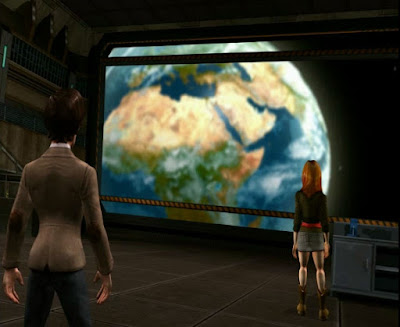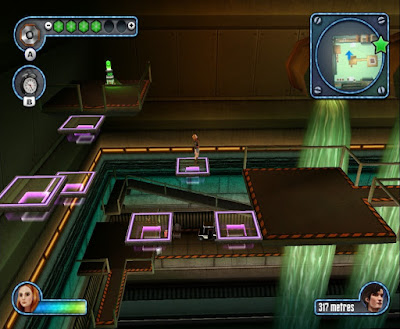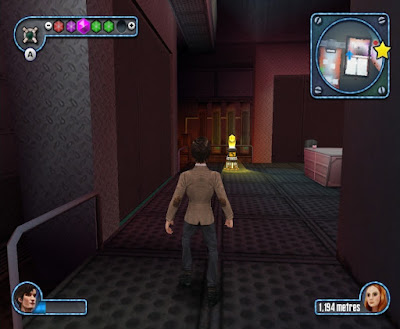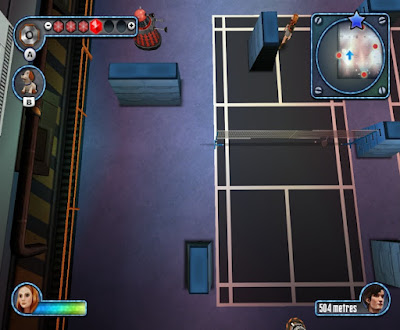 |
| The TARDIS encounters the beleaguered starship, Lucy Gray. |
Written by: Oli Smith. Directed by: Jon Hare. Produced by: Glen Parry, Simon Bailey, Howard Neumark. Released by: Asylum Entertainment. Platform: Nintendo Wii.
THE PLOT:
The Doctor and Amy are drawn to the Lucy Gray, a giant starship that's been battered by an asteroid field. Getting onto the ship is difficult, and the time travelers are quickly separated. Worse, the TARDIS is in outer space - not far, but far enough to be totally inaccessible!
They work their separate ways through the ship, whose entire crew is in cryo sleep. All systems are mechanized, and the asteroids have left some systems on fire and others out of order. It falls to the Doctor and Amy to fix these problems by collecting colored crystals and zapping balls of the same color with their Wii-motes... er, sonic screwdrivers (yes, Amy gets one too, parceled out by the ship itself!).
The Doctor discovers that the ship's current state is part of a plan by the Cybermen, who have taken control of the ship's main computer. The computer gets a message out to the Doctor, trusting him to save the Lucy Gray again.
Which is odd, since he's sure that he's never been on this ship before...
 |
| The Doctor and Amy stare out at the planet Earth. |
CHARACTERS:
Matt Smith and Karen Gillan do a fair amount of voice work for this game - though an awful lot of that consists of telling the player how easy a task was after that player has just spent far too long struggling with the horrible controls to actually accomplish it. "Well, that was easy," the Doctor smirks - after missed shots have left me traversing the same moving platform three times to collect the right crystal to open a door.
One of the very few nice things I will say about Return to Earth is that Smith and Gillan give slightly better performances than in DS counterpart title, Evacuation Earth. Even so, the comment I made in my review of that game, about it sounding as if they were sight reading lines that had been just handed to them? That still mostly applies, with their line readings carrying a stilted, oddly emotionless quality throughout.
 |
| Amy traverses moving platforms to collect some crystals. |
GAMEPLAY:
Return to Earth's gameplay is ridiculously repetitive. To summarize most levels: Move down a corridor (or in later levels, across moving platforms) to obtain crystals of various colors. Find a bouncy ball of the same color. Use the "1" and "2" buttons to cycle to the correct crystal, then zap the bouncy ball. Red crystals puts out fires. Green crystals unlock doors. Orange ones will open "secret areas" where you can pick up cash to unlock production art (exciting!). And blue ones allow you to "repair the circuit" to finish a level.
As if sensing that this was too simple even for a game marketed to children, the developers added stealth. Really bad stealth, worked into every facet of this game. Not only do you have to sneak around avoiding enemies - You have to sneak up on the crystal dispensers, because they'll seal shut if they spot you! This makes no sense at all, and it quickly becomes frustrating when the dispenser you need is located right next to an enemy.
Oh, and if an enemy sees you? Your only recourse is to flee, because the Doctor and Amy are not allowed to defend themselves. If a monster spots the Eleventh Doctor, the incarnation most likely to resort to violence (at least of the ones who don't have the word "War" in their title), he is as helpless as a newborn kitten.
Finally, most chapters end with a mini-game in which you complete a circuit by navigating a ball through a maze filled with fans, lasers, and other obstacles. In some cases, you do this while being chased by another ball, which throws in the added "fun" of rushing you through these mazes. These sections are pure torture, and I'm pretty sure their only reason for existing is to pad out the running time.
 |
| The Doctor sneaks up on a dispenser. This takes up a surprisingly large amount of the game. |
A PROBLEM OF CONTROL:
Nintendo reportedly paid £10 million for the gaming rights to Doctor Who. And then promptly gave that high-priced license to Asylum Entertainment, makers of cheap shovelware often based on licensed product. Since they spent so much to get the license, couldn't they have spent a comparable amount to get a competent developer to make a game someone might actually want to play?
The Official Nintendo Magazine labeled Return to Earth "an insult to Doctor Who fans," and it's hard to argue. The game is visually ugly, its graphics below par for a PS1 title, never mind something made in 2010 for the Wii! It's hard to credit that this belongs to the same console as: Xenoblade Chronicles, Fire Emblem: Radiant Dawn, or The Legend of Zelda: Skyward Sword.
Gameplay is aggravating, all the more for attempting to utilize the Wii's motion controls. Even when well-implemented, these tend to leave me struggling with the Wii-mote to make whatever motion the game wants and have the console detect it correctly. But well-implemented isn't an issue here - Return to Earth's controls are horrible.
As I've mentioned, much of the game consists of using the Wii-mote to shoot colored bouncy balls. Aiming is less than terrific, which in fairness is not surprising for a Wii game. But this is made so much worse by the time limit! Yes, if you take more than three seconds to aim, you will prematurely fire your colored crystal into thin air. Also, all those moving platforms? Be careful walking from one to the next, because there is noticeable input lag. By the time the Doctor or Amy moves from their current platform, the destination has moved on; if you didn't start the move early, your character will plunge to their doom.
But all of that pales in comparison to this:
 |
| The task that almost defeated me: Unscrewing a panel to get to the actual puzzle! |
Yes, I was almost defeated two chapters in by the simple task of using the Sonic Screwdriver to unscrew a panel. What you're supposed to do is press the "A" button while twisting in the correct direction, to simulate a screwdriver. This is about as simple a motion control task as can be devised... but I couldn't do it, because my sensor bar couldn't detect the turning motion. I spent more time sorting that out than I did playing through the next three chapters combined.
STORYTELLING:
Writer Oli Smith tries to do something interesting in the way he links this story up with Evacuation Earth. Both games revolve around the Doctor and Amy helping the Lucy Gray. Evacuation Earth happens first chronologically... but for the time travelers, it occurs second. In the DS game, they are familiar with the Lucy Gray, but they are strangers to everyone around them. In Return to Earth, the ship's computer hails them as heroes and trusts them to save the ship "again," with the Doctor and Amy having no idea what she's talking about.
Unfortunately, the storytelling is sabotaged by the game's format. Evacuation Earth may have been a blatant Professor Layton ripoff, but at least its adventure/puzzle format allowed for character interaction and a sense of building events... at least for the first half. Return to Earth has no guest characters, probably because the budget wouldn't stretch to three dimensional models of people other than the regulars. The Doctor and Amy are separated for almost all of it, so the only real interaction is with the ship's computer.
Oh, and the game features the exact same problem as Evacuation Earth. The actual story gets resolved... and then an extra Act is bolted on for no reason other than to throw some Daleks into the mix. Because you can't have Doctor Who without Daleks. Except for, you know, the vast majority of the actual television series...
 |
| In fairness, I've seen worse PS1 graphics... Wait, what do you mean this was for the Wii? |
OVERALL:
If you're curious to know if the Doctor Who Wii game is as bad as its reputation... Yes, it is. Return to Earth is ridiculously repetitive, ugly to look at, and frustrating to play. The only positives I can think of are: (1) it uses music from the show, so there's at least one competent element; and (2) it's extremely short. Unless you feel a ghoulish need to experience this trainwreck for yourself... Avoid!
It's hard to credit that the best Doctor Who game I've played so far is a Match Three mobile title...
Overall Rating: 1/10.
Set During: Series Five
Review Index
To receive new review updates, follow me:
On Twitter:
On Threads:











